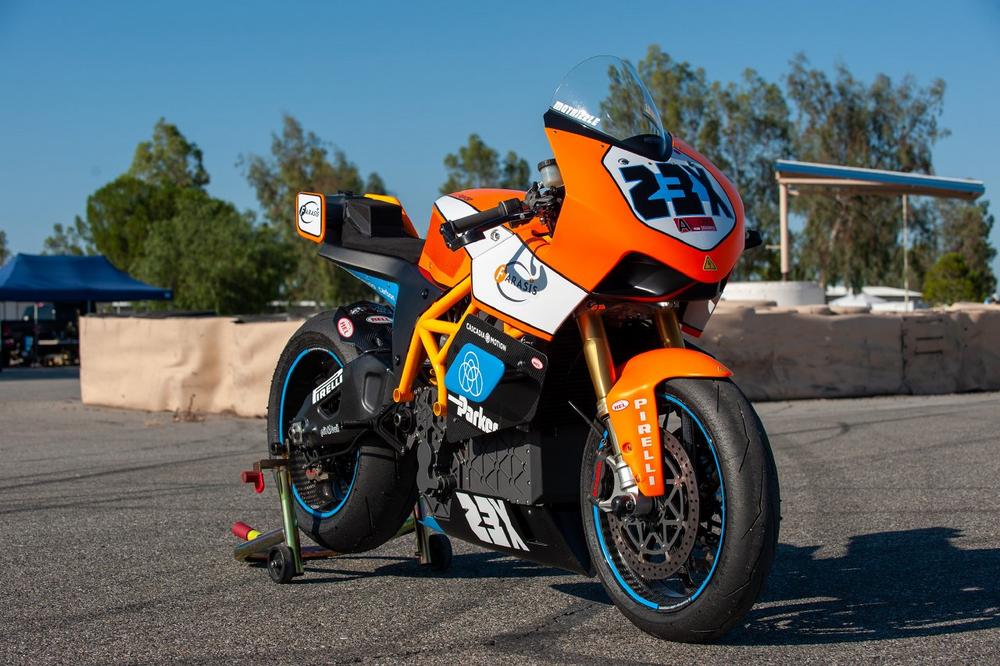- Lightfighter and thyssenkrupp Carbon Components to revolutionise electric motorcycle racing
- Carbon wheel benefits highly valuable for electric motorcycles
- Second US racing venture for thyssenkrupp Carbon Components after Pikes Peak International Hill Climb
An electric race bike, built almost completely from custom parts, developed to compete in the Supersport 600cc category for the power to weight ratio and a team of (electric) motorcycle enthusiasts are the foundation of the Lightfighter Racing project. The motorcycle is a 1-of-1 prototype, but designed to pave the way to more accessible high-performance, track-focused electric motorcycles in the future – an aspiration for which the unique braided carbon wheels of innovative German manufacturer thyssenkrupp Carbon Components are suitable in an excellent manner. Named after Lightfighter Drive on Highway 1, which was on Brian Wismann’s, the project designer and builder, way to Laguna Seca Raceway in California, USA, the Lightfighter is developed and built for club racing and is aiming to mingle with the forefront of motorcycles with internal combustion engines.
Starting from the idea to change the standard of electric racing motorcycles, the team around Ely Schless, Brian Wismann and Troy Siahaan challenged the standards which were and are mainly set by those motorcycles racing the TT Zero at the Isle of Man. These motorcycles are developed with a focus onto the battery, in order to cover the distance of the Mountain Course on the Isle of Man. The core of the Lightfighter project is, however, the geometry of the motorcycle. Having innovation, high engineering standards and lightweight as well as a little bit of the Isle of Man spirit at its core, the Lightfighter project and thyssenkrupp Carbon Components have more in common than one might think at first glance.
After the first Lightfighter prototype having had a successful outing in 2019, the winter months and following pandemic lockdown saw an improved version of the Lightfighter – namely Lightfighter v2.0 – become reality. Being innovative and creative by design, the braided thyssenkrupp carbon wheels support one of the Lightfighter’s key features: its ultra-light weight. With 181 kilograms (399 lbs), the Lightfighter v2.0 equipped with the unique carbon wheels is significantly lighter than comparable electric racing motorcycles. This extraordinary weight reduction leaves the rider with an instant gratification of the performance advantages. A quicker acceleration as well as massively improved handling and agility are amongst the benefits of the usage of the unique wheels made of carbon fibre.
The Lightfighter v2.0 was completed by a main tubular chrome and steel trellis chassis, lithium-ion battery pack, and motor/gearbox unit, which are all designed specifically for this motorcycle. Another substantial improvement is the new battery, as it also integrated the main contactor, DC-DC converter, and smaller relays into the top, making the whole system simpler and safer to work on. Through quick-swap capability, it dramatically improved the recharge time of five to ten minutes, compared to the 1 to 1.5 hours it would take to recharge from a 220V/50A circuit.
Turning from the mechanical details to the racing plans of the project meant a long wait for the Lightfighter team, with the first test finally being underway at Buttonwillow Raceway Park in early July of 2020. The first race of the Lightfighter v2.0 with the WERA organisation proved to be a challenge, but a successful one. Competing in the Formula 2 and B-Superbike class races, motorcycle.com road test editor and LF rider Troy Siahaan was in the mix at the front all along and secured an outstanding third as well as first place for the electric motorcycle on braided carbon wheels and the team behind it. After another test with major changes, the continuous development and innovation of the Lightfighter project and their experiences with the thyssenkrupp carbon wheels will continue to showcase the potential of electric racing motorcycles in 2021.
thyssenkrupp Carbon Components develops and produces carbon wheels for automotive and motorcycle manufacturers and also supplies end customers with motorcycle wheels. The company in Kesselsdorf near Dresden, Germany was founded in 2012.
All carbon wheels by thyssenkrupp Carbon Components are manufactured highly automated with a patented braiding technology on the world’s largest radial braiding machine. Thus, it is possible to achieve the highest quality and lightweight requirements at the same time. The official NAFTA importer and distributor for thyssenkrupp carbon wheels is ThyssenKrupp Bilstein of America, Inc.
Action Composites GmbH
M
01723 Kesselsdorf
Telefon: +49 (351) 32039-504
Telefax: +49 (351) 32039-513
https://www.action-composites.com
Telefon: +49 (351) 32039530
E-Mail: marketing-carbon-components@thyssenkrupp.com
Telefon: +49 (351) 32039-530
E-Mail: marketing-carbon-components@thyssenkrupp.com
![]()

